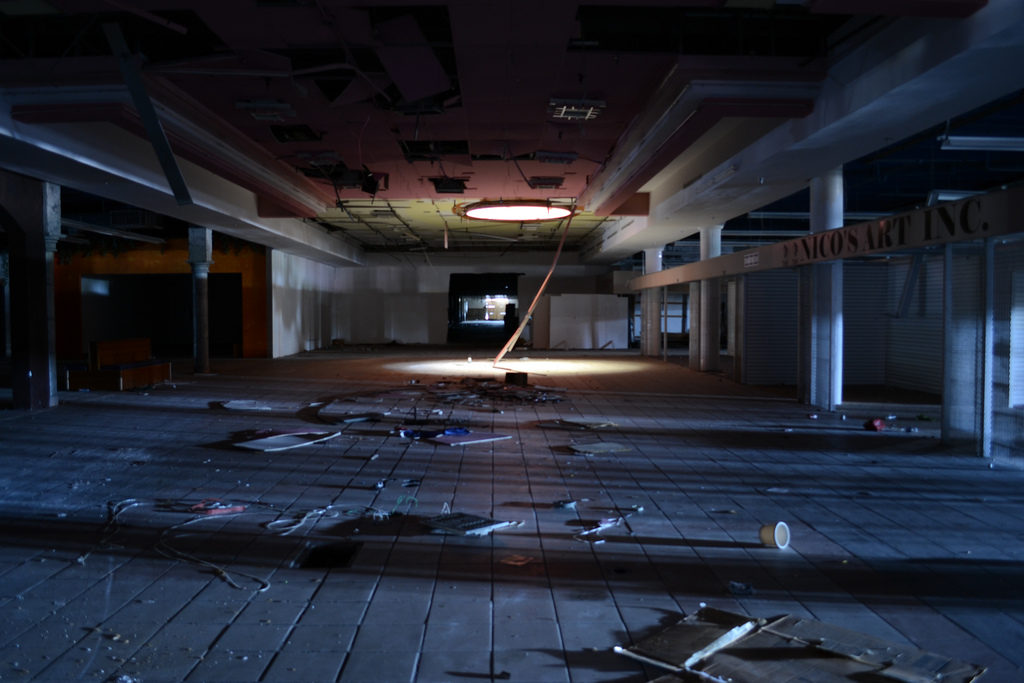Podcast: Play in new window | Download
Subscribe: RSS

Mall gone.The malls of America rose with the big-spending middle class, and are declining as the big spenders disappear. (Photo by Brett Levin/Flickr)
After announcing the closing of 40 stores in January, Macy’s said last week it will shutter 100 more in the face of declining sales and profits at its brick-and-mortar stores. After the company announced the closings, along with a 95% reduction in profits, and chronically declining sales, and the layoffs of 4,000 people that will follow them, Macy’s stock immediately shot up 18%. (If that fact, all by itself, does not motivate you to get everything you own out of the stock market and at least 20 miles away from it immediately, then good luck, God bless, and we’ll hope to see you on the other side.) In May, Aeropostale announced the closing of 154 stores in North America, and slithered into bankruptcy. Meanwhile Sears, J.C. Penney, Radioshack and other stores closed by the hundreds under previously announced plans.
As the Great Economic Recovery of 2009-2020 continued (both the Dow Jones and the S&P stock indexes hit new historic highs, simultaneously, this week) Macy’s announcement deepened the longstanding gloom not only in the brick-and-mortar department-store sector, but in the world of shopping malls. As USA Today reported, “Chain-store closure announcements have cascaded this year even though the U.S. economy has been generally strong.
They have included Ralph Lauren announcing it would close 50 stores. Sears said it would shutter 78 Sears and Kmart stores. Aeropostale is closing 113 locations.Sports Authority is closing down the entire chain Tailored Brands said it will close 80 to 90 Jos. A. Bank stores, mostly in January, plus 58 factory and outlet stores and up to 110 MW Tux stores. Kohl’s is going to leave 18 underperforming stores. Chico’s and White House Black Market are spacing out the net reduction of 105 stores total.”
With absolutely no sense of irony at all, USA Today goes on to make the mandatory “on-the-other-hand” point by saying that some chains are actually expanding, such as bottom-feeders Dollar General and Marshall’s. So never mind that your Macy’s has closed, refresh your fall wardrobe at Dollar General.
Nothing is more quintessentially “American” than the shopping mall, and hardly anything is more central to modern American life. I cannot forget the obstetrics nurse who, on hearing that one of her newborn patients had just been made an orphan, cried, “Aw, man? Who’s gonna, like, take him to the mall?” That’s a void that Dollar General is not going to be able to fill.
Department stores are the dinosaurs of this retail age. Legendary retail consultant Howard Davidowitz calls them the “worst segment in retailing,” because they are offering style and selection when the consumer is looking for only one thing — a better price.
This great dying of the department stores and the malls does not arise only from the fact that online retail sales are growing modestly, as most reporting would have you believe. Nor are they the victims of a normal notional change in consumer fashion whims. The root cause of this spreading crisis in American retail business was defined by none other than Mr. Davidowitz, a year or so ago, in the single most pungent analysis of our economic time that I have seen: the problem is, he said, that consumers “don’t have any fucking money.”
“Even though the U.S. economy,” warbles the don’t-worry-be-happy chorus and USA Today, “has been generally strong.”
Yes, Mr. Lewis, the derelict malls reflect the abandonment of the (former) middle class. Like the vacant and rotting former Olympic sites around the globe, they served their purpose and were quickly forgotten. Unfortunately, this has also happened to America’s infrastructure too – gas mains, water and sewer systems, roads and bridges, and the electrical grid are in the same category. Apparently only the military and the medical fields still enjoy large monetary input (and the latter is becoming unaffordable). All of these are evidence of the slow-motion economic train wreck that will ultimately end in the abrupt collapse of civilization, where money (and gold) becomes worthless because there’s no food to buy, no potable water left, and chaos ensues. As soon as the current climate-change driven crop losses and species die-offs happening around the world reach some critical point, the effects will ripple through the “food chain” and this whole experiment will conclude with the human species finding itself in the same sinking boat as all the others we’ve driven to extinction.
Thanks for bringing this to our attention.
Consumerism, at least according to some, was a brainchild of the evil genius Eddie Bernays, of “Propaganda” fame, working with the currently stumbling Macy’s retailer.
The idea that otherwise moderately intelligent people can be reduced to idiots dashing around madly to acquire mounds of useless crap was hardly a beneficial development.
While I generally look to this unfolding collapse ruefully, when it comes to the demise of consumerism, I wholeheartedly applaud it.